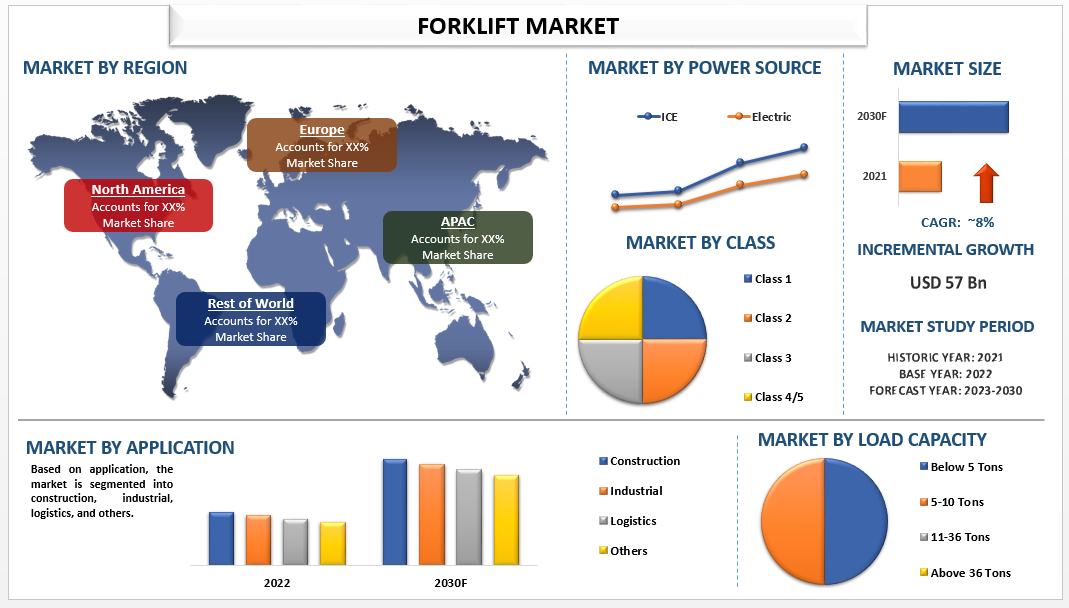In the symphony of industrial progress, forklifts emerge as the unsung heroes, orchestrating the seamless movement of heavy materials in diverse sectors. The Forklift Market, poised for a commendable CAGR of around 8% over the forecast period, is witnessing a surge in demand propelled by various factors reshaping the global economic landscape.
Driving Forces of Forklift Demand
Construction Boom Fuels Need for Robust Forklifts
The burgeoning construction industry on a global scale is a driving force behind the escalating demand for robust forklifts. With governments worldwide focusing on infrastructure development, such as the South African Government’s ambitious USD 56 billion investment by 2027, the demand for forklifts capable of swift material transfer is set to skyrocket.
Access Sample PDF Here- https://univdatos.com/get-a-free-sample-form-php/?product_id=48419
E-commerce Surge: A Boost for Forklifts
The exponential growth of the e-commerce sector is reshaping material handling dynamics. As consumers pivot towards online shopping for convenience and safety, the demand for high-quality forklifts in e-commerce distribution facilities is on the rise. This surge in demand is further amplified by the rapid expansion of the global logistics industry, now valued at over USD 9 trillion.
Technology-Driven Market Opportunities
In the era of modern material handling, forklifts have evolved beyond simple lifting machines. The integration of advanced technology is revolutionizing their utility. Forklifts are no longer just about lifting materials; they are integral in monitoring and tracking operator performance and overseeing mechanical and power systems. Manufacturers’ relentless efforts to produce technologically driven trucks are opening substantial market opportunities.
Market Dynamics: Insights Unveiled
Class Segmentation: Class 2 Takes the Lead
In the segmentation based on class, Class 2 forklifts emerge as the dominant force, capturing the largest market share in 2022. The proliferation of storage facilities and warehouses, coupled with the maneuverability of Class 2 electric, narrow-aisle models, positions them as the go-to choice. Looking forward, the report predicts the Class 3 segment to dominate by 2030, driven by demand from small and medium-sized warehouses.
Load Capacity: 5-10 Ton Segment Dominates
Analyzing load capacity, the 5-10 ton segment holds the throne in 2022. These forklifts, versatile in handling diverse materials, are witnessing heightened demand due to the growth of industrial sectors, including warehousing, logistics, and manufacturing. Their indoor and outdoor adaptability, fueled by natural gas, liquid propane, or gasoline, is a key factor in their market dominance.
Browse Research Methodology, Report Description and Table of Content- https://univdatos.com/report/global-forklift-market
Regional Supremacy: Asia-Pacific Leading the Charge
Asia-Pacific stands at the forefront of forklift market leadership. The region’s inclination toward plant automation, increased R&D investment, and a favorable economic environment contribute to this dominance. The demand for cutting-edge material processing equipment in industries such as construction, mining, and food and beverages further fuels this growth. Noteworthy is the recent launch of Mitsubishi Logisnext’s MX2 and MXL Series 4-wheel electric pneumatic forklifts, a testament to the region’s commitment to technological advancement.
Conclusion: Navigating the Forklift Frontier
As we navigate the forklift frontier, it becomes evident that these machines are not mere tools; they are catalysts for industrial efficiency. The global forklift market, fueled by construction endeavors, e-commerce dynamics, and technological innovations, charts a course toward unparalleled growth. In the intricate dance of material handling, forklifts lead the way, ensuring the seamless flow of goods and the realization of a more efficient industrial landscape.
Contact us:
UnivDatos Market Insights (UMI)
Email: [email protected]
Ph: +91 7838604911


